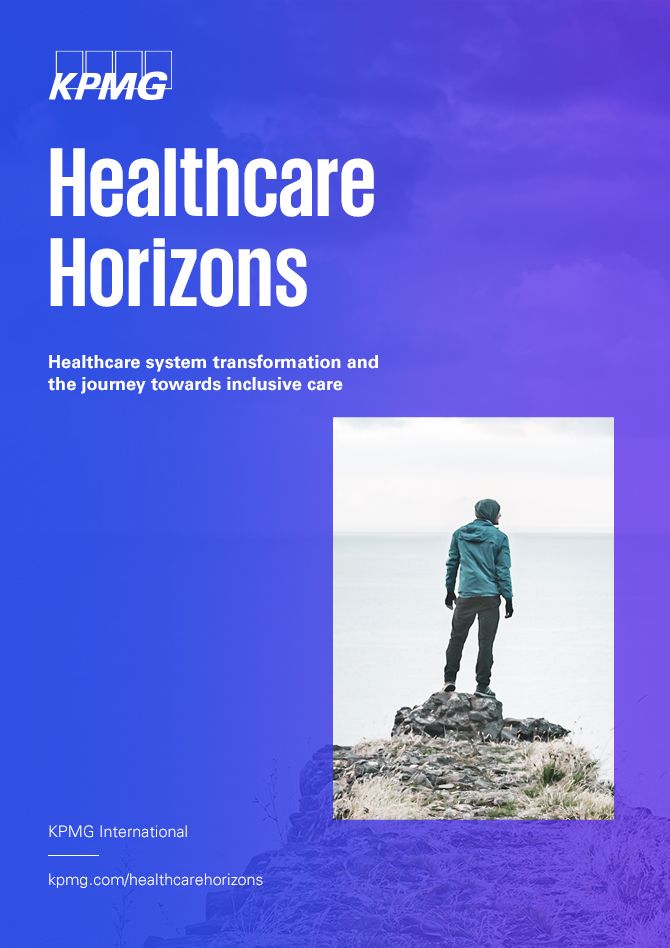Preview
Identifying areas of change that are critical to developing inclusive future healthcare systems
Highlighting healthcare transformation milestones for the next decade
It is said that the best way to predict the future is to create it. Whether the predictions and scenarios projected in Healthcare Horizons are realistic or not is for individual healthcare leaders to debate and decide. The point is to consider the future waves of crises and trends that are just over the horizon – and in some cases already here – and use these to re-evaluate existing strategic plans. Leaders should ask themselves:
- “Of the projects we have planned, which ones are really going to equip us for the future?"
- “Who do we need to work with (governments, payors, providers, community organizations) to move our system towards an inclusive scenario?”
To turn the insights provided in Healthcare Horizons into action, at KPMG we offer an overview of the most pressing areas for change as a new agenda for healthcare leaders. Envisioning the end goal of an inclusive health system scenario is certainly easier than agreeing on the messy realities of getting there. So how can health leaders be sure that their organizations are moving in the right direction? Each transitional agenda will be unique, but they are likely to share a number of common features.
The agenda for ‘Inclusive’ healthcare systems in 5 years
In the first five years, we predict that inclusive health systems will likely have a preoccupation with three key priorities. First will be a redesign of health services and organizations to better reflect the needs of patients and local communities. This may involve vertical integration of hospitals, primary and community care, and governance reforms to create a stronger voice for local community groups in decision-making. We are likely to see the gradual emergence of ‘hybrid’ care pathways where health professionals in multiple settings move away from ‘hand overs’ and multi-disciplinary meetings and towards simultaneous collaboration and shared monitoring of patients – an early example being the recent rise of virtual wards.
The second priority will be around building towards new data architectures to support this integration, as well as empowering patients. Integrated or interoperable EMRs may be a first step, closely followed by the development of health data centers to transform linked data into actionable insights that can be used to establish proactive population health management approaches. Data centers will gradually expand as new feeds are added, such as real-time service performance information and links across to data held by non-health organizations. There may be an initial challenge to develop the data science capabilities to use this information, but this will ease as global tools and platforms for population health management expand and artificial intelligence grows increasingly powerful.
The third priority will be around early advances in creating more agile health workforces. The pace of change in workforce regulation will vary considerably by country or territory, but many organizations may be able to begin moving to integrated scheduling and rostering across organizational boundaries, enabled by more detailed understandings of tasks and skills needed, rather than roles. An easier shift for many will be the automation of administrative tasks, which can be readily adopted by artificial intelligence increasingly being used as a clinical decision support.
The agenda for ‘inclusive’ healthcare systems in 10 years
Within a decade, we predict that the agenda for inclusive healthcare organizations will have shifted further, with changes in data, workforce and community engagement cumulatively transforming how health systems operate and are understood. In some ways, the changes will mirror those occurring already in consumer technology industries – individuals will likely have ultimate ownership and control of their data, accessing health tools and training as they would with consumer apps today, and engaging with healthcare across a range of channels according to their choice – voice, text, in-person in the community, in emerging settings in the metaverse, or at a hospital, if necessary. Caregivers and community members can be micro-credentialed in the same way as staff, blurring the boundaries between patients, citizens and the workforce. Healthcare workers will be employed across systems, rather than for specific organizations, and healthcare workforces will likely include informal workers as well as many staff based overseas.
Yet in other ways, inclusive healthcare systems of the future will be quite unlike that of today’s technology giants. There will be strong links with, and democratic accountability to, citizens and community groups, who will ‘own’ (whether formally or informally) a major stake in their local providers, who will give them sway in decision-making, and who will rely on their support to operationalize a decentralized model of data sharing through community-owned decentralized autonomous organizations (DAOs). The emphasis will be on supporting self-management through choice and personalization, rather than any need to drive ever-greater engagement with ‘the system.’
Horizon milestone timelines
So, what does this all mean in terms of the practical ‘to do’ list for health leaders today? The breadth of change required may be dizzying but can be distilled into a number of milestones over the coming years.
See pages 35 and 37 of the
Conclusion
This is a radical agenda for any organization and will require planning for crisis and change horizons rather than the typical one- or four-year business planning cycles. At KPMG, we feel that unless action is taken across all of these areas, healthcare organizations likely will be unable to stay afloat amid successive waves of crises and challenges that are expected to batter the sector.
It can be daunting to work out where to start: how can future trends and the above agenda really translate to the specifics of local geography and circumstances? Depending on local priorities and current capabilities, organizations may wish to tackle each element sooner or later, but ultimately all will be critical to developing inclusive healthcare systems. KPMG firm professionals can help organizations to navigate storms of change and plot the potential approaches mentioned above into a coherent plan of action for what should be done in the years ahead – be that for overall ‘inclusive’ masterplans or individual elements such as strategic reforms to data, workforce, environment, community engagement and partnerships.



